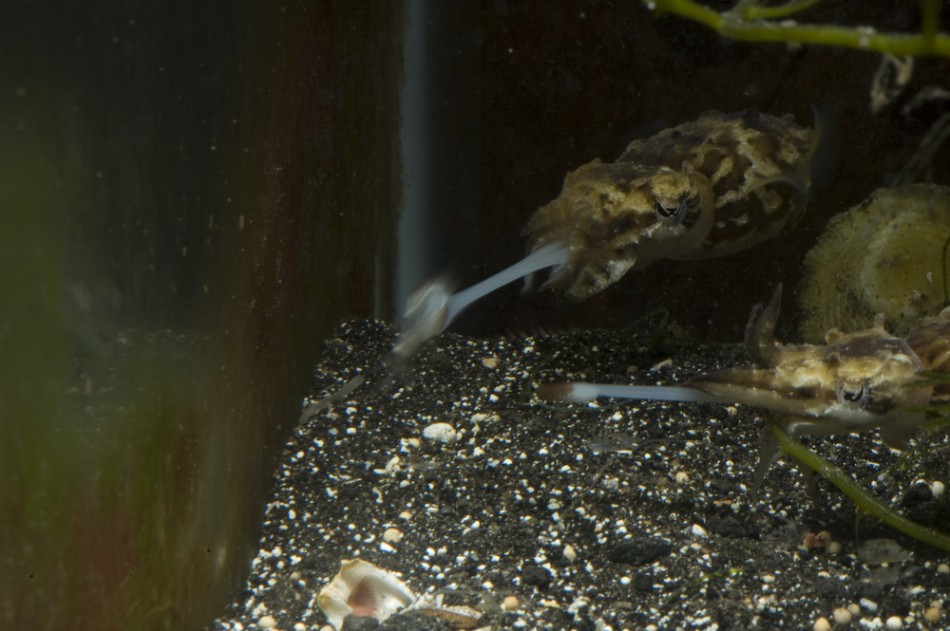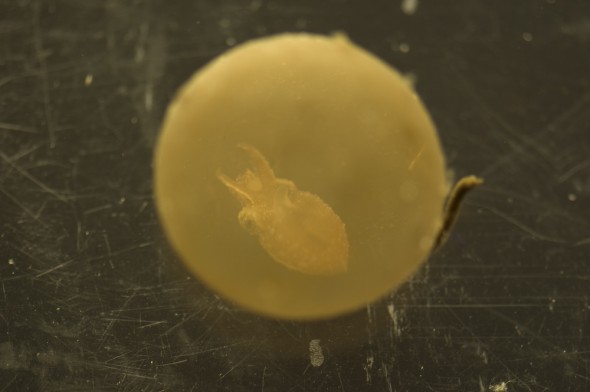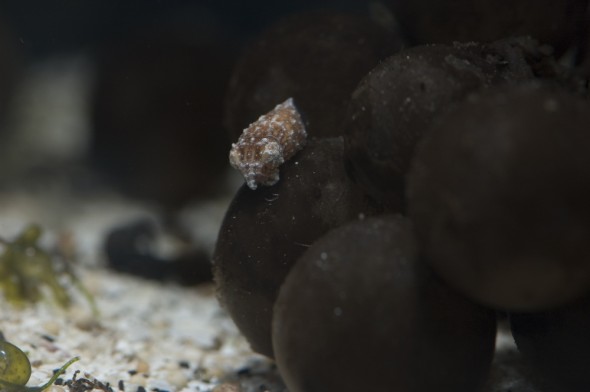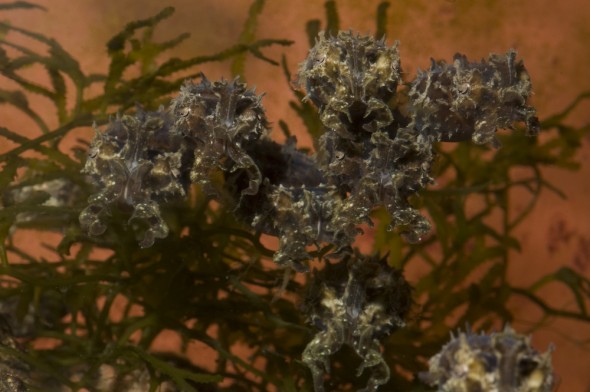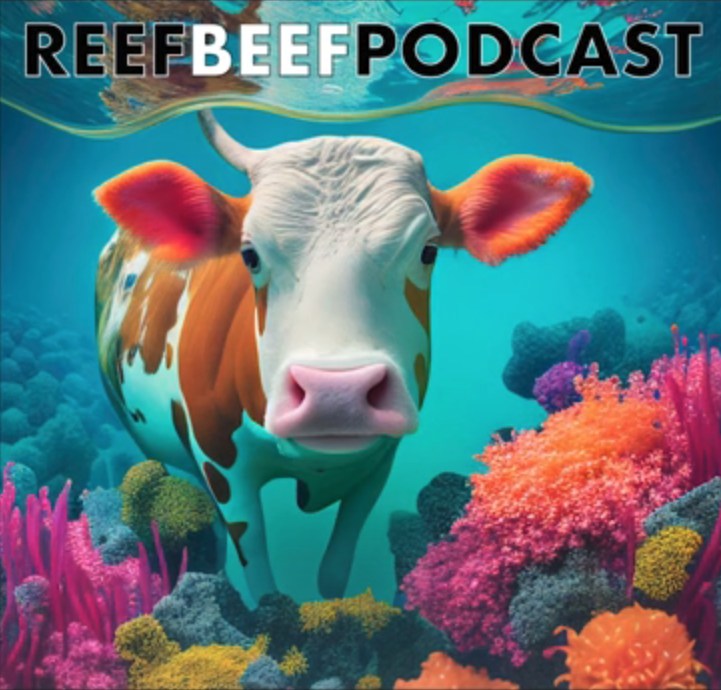first appeared in Tropical Fish Hobbyist (TFH) Magazine in 2009.
Wild collected adult Sepia bandensis ship poorly with high mortality rates and, since they are adults, they may only have months or weeks left to live when they finally arrive at your home. However, in the last few years, alternatives to wild caught adults have presented themselves. Wild caught eggs appear on the market with regularity, and our understanding about how to raise the eggs and hatchlings has advanced greatly. Even more exciting is the success people have had captive breeding Sepia bandensis, and captive bred eggs and hatchling cuttles are offered for sale by breeders with increasing regularity. The means that not only is nothing is taken from the wild, but the availability of Sepia bandensis is no longer dependant on the seasonal availability of wild animals. This article will cover the basics of keeping and breeding these amazing creatures.
Cuttlefish basics
Sepia bandensis are cephalopods, related to octopus, squid and nautilus. Sepia bandensis have 8 arms, two feeding tentacles, three hearts, a ring shaped brain, a cuttle bone that helps control buoyancy, a fin that girds their mantle for fine maneuvering, a funnel that gives them ‘jet’ propulsion, superb 360 degree vision (though it appears they are color blind), copper based blood and the ability to squirt ink. They mate readily at around 5 months old, and lay clusters of ink covered eggs that resemble clusters of grapes. When the hatchlings are born they are tiny, less than a ¼ inch long, but can grow to an inch long within two months, and to about 4 inches within 6 months.
An awful truth
Sepia bandensis only live about one year. What makes this short lifespan even worse is how many cephalopods die; they go into what is called senescence. In senescence, the cephalopod essentially wastes away; they become listless, their eyesight and coordination start to fail causing them to have difficulty hunting or even accepting food placed directly into their arms. Sometimes their arms and body will begin to rot in place. I have seen hermit crabs feeding of still living Sepia bandensis while the cuttlefish does nothing, showing no signs that they are even aware of what is happening. In the wild, cuttlefish going through senescence don’t last long, quickly being eaten by other animals. In captivity, however, with careful feeding by the aquarist, it is possible for such a cuttlefish to linger for months while slowly declining. At some point during this process, some cephalopod keepers choose to euthanize senescent animals rather than watch them suffer. The best way to intentionally end the life of a suffering cuttle is still up for debate, but the two most often used methods include freezing the animal in a cup of tank water, or using one of the commercially life ending chemicals produced by aquarium companies.
I bring this up because it is important to be ready for this aspect of keeping a cuttlefish, and to drive home the point that captive breeding of these animals is important. If you captive breed them, it seems to somehow make the short life of the animal feel less tragic and more meaningful.
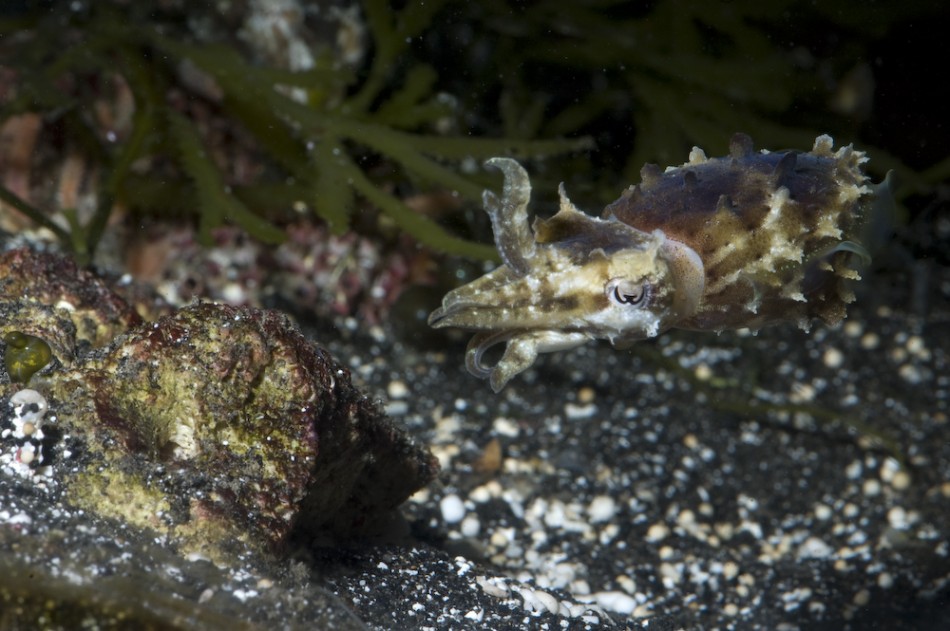
General husbandry
The basic requirements for Sepia bandensis husbandry are roughly the same as for coral – clean stable water conditions that simulate natural salt water conditions. I suggest live rock for biological filtration with ammonia and nitrite levels of zero and nitrate levels as low as possible. Specific gravity should be near 34.5ppt, temperature around 78 degrees Fahrenheit, and pH should be between 8.0 and 8.5. A skimmer is a must, not only for the oxygen it puts into the water and the waste it skims out of the tank, but they also do a great job of removing any cephalopod ink from the water before it has a chance to do any damage to the animals. With the amount of waste these predators create from unconsumed food, adding a phosphate reactor with phosphate adsorbing media may also be a good idea. Finally, if nitrates become a problem, a sulfur denitrator or remote deep sand bed for natural nitrate reduction can be added.
A single Sepia bandensis can live well in a 30 gallon aquarium, and many of the ‘all in one’ aquariums on the market right can work very well as a cuttlefish tank. For two Sepia bandensis I don’t recommend anything smaller than 40 gallons, 3 Sepia bandensis have done well in a 55, and I have kept groups of 8 in 125 gallons. Groups of Sepia bandensis can be kept together as long as they are kept fed and they have enough space. Without enough space or food, the cuttlefish will fight and possibly damage or eat each other.
Sepia bandensis has no specific lighting requirements, and will thrive under simple fluorescent lights or more powerful metal halide lighting. Similarly, Sepia bandensis will thrive under different levels of water flow, but I suggest you err on the side of more flow rather than less.
The aquascaping for a cuttlefish tank is mostly up to the personal preference of the aquarist, as the cuttlefish will thrive in a wide variety of set ups. Some caves or overhangs for the cuttles to hide are good for the animals. Growing macro algae can also provide nice hiding places for the cuttles to hang out, as well as potentially up taking excess nutrients in the water. A inch or so of sand is also a nice addition to the tank as the cuttles will sometimes bury themselves in sand, but their digging may be detrimental to deeper sand beds.
Cuttlefish can be messy eaters, dropping uneaten food all over the tank, and it is important to get that food out before it begins to rot causing deteriorating water quality. Hermit crabs and snails are safe from predation by cuttlefish and can help with uneaten food. In my opinion, bristle worms make great tank janitors for cuttlefish because they breed readily, and quickly consume dropped food.
Fish as tank mates should be avoided. If we follow up most stories of cephalopods being kept successfully with fish, we find that the success only lasts a few months before the fish eats the cephalopod or the cephalopod eats the fish. Corals on the other hand, as long as they are not stinging, make great tank mates for cuttlefish. There is at least one Sepia bandensis breeder that has had great success breeding Sepia bandensis in a full blown reef tank with bright metal halide lighting and massive flow.
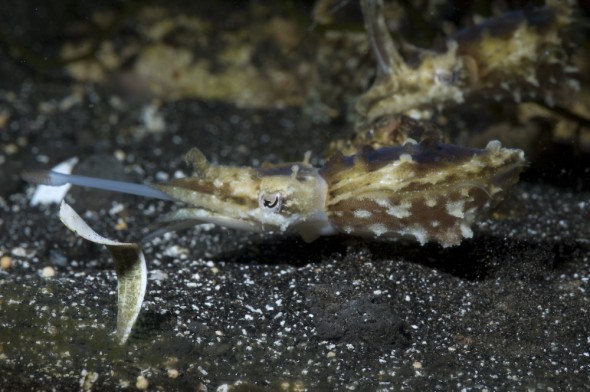
Sepia bandensis start off small and get larger quickly, which means their food needs and living space needs change as they grow. While its easy to say two Sepia bandensis can live comfortably in a 40 gallon tank, the reality of the situation is that you probably don’t want to put two hatchling cuttlefish in a 40 gallon tank because you will never see them or be able to know if they are eating. Hatchling cuttles are only ¼ of an inch long and can be completely lost in a larger tank making it impossible to even know if they are feeding.
An easy way to deal for this aspect of Sepia bandensis husbandry is to keep hatchlings in some sort of nursery, such a commercially available ‘net breeder’ used most often for live bearing fish. When setting up the net, I suggest turning it inside out so the hatchlings don’t get caught up in extra netting at the seams. Hang-on tank refugiums can also be used, or small nursery aquariums plumbed into the system – although you must take precautions to ensure the hatchlings won’t be washed out of the container by water returning to the tank, such as foam filter sponge over the outflow.
I like net breeders because they are simple, inexpensive, and incredibly easy to set up. The net breeders hang on the side of the aquarium and allow water to flow freely through the net, so no extra filtration or plumbing is needed. You can easily look through the top to keep track of the health of the cuttle and track its growth. I have successfully kept 4 hatchling Sepia bandensis in net breeders for the first 2-3 months of their lives, and once they grow to about an inch in length they can be let loose in the larger tank.
Net breeders are also great because they keep hatchling cuttlefish in close proximity to their food. For at least the first 2 of weeks after hatching, Sepia bandensis will need some sort of live food, and keeping the food closer to the hatchlings makes it more likely they will be able to find it to eat it. The more they eat, the faster they will grow, and the sooner you can release them in to their permanent home.
By far, the most successful food for hatchling Sepia bandensis is live mysis shrimp. Mysis are highly nutritious and relatively easy for the hatchlings to catch. The drawback to this food is the expense and the effort. Collecting wild mysis and captive culturing mysis are both extremely labor intensive, so they can cost more than one hundred dollars for 200. I prefer cultured mysis to wild mysis, because in my experience they have better survival rates, but plenty of other cephalopod keepers have had great success with wild mysis.
It is important to note that live brine shrimp, though readily available and inexpensive, are widely considered terrible food for cephalopods. Cephalopods raised on live brine, even enriched live brine, have low survival rates and short lives.
Keeping any live food alive can be challenging, and the challenge is compounded with mysis because they can be cannibalistic. To reduce this potential issue, avoid overcrowding, and be sure to feed rotifers or other suitable food regularly. Net breeders can be utilized, or another small tank can be set up to keep the mysis until they are ready to be fed to the cuttlefish. Its also important to get a feel for how many mysis you need per week, and be able to order them before you run out so your cuttlefish don’t go starve or eat each other!
If you are lucky enough to live near the ocean, you may be able to collect your own hatchling cuttle food in the form of small amphipods. Make sure to collect from waters that are as unpolluted as possible, and make sure to check with local regulations regarding collection before beginning. Amphipods can be much more robust than mysis and they can escape from hatchling cuttlefish more easily. I recommend that you start with mysis for the first week or so, allowing your baby cuttlefish to learn hunting skills with the easier prey.
Hatchlings should be fed several times a day, and only as much as they catch in a few minutes. I recommend avoiding ‘flood feeding’, feeding a lot of live food at once, because not only can hatchling Sepia bandensis stop seeing them as prey items, but flood feeding can make the hatchlings harder to wean onto dead food.
Since live food can be expensive, its great to wean your cuttlefish onto thawed frozen food as soon as possible – frozen mysis are a good choice for size and nutrition. Since cuttlefish rely on their eyesight to hunt, often the dead prey may need to be moving to get the cuttlefish to strike. Start by introducing thawed mysis with your live food. The hatchlings, conditioned to striking when live food is dropped into their breeder net, will usually snap up the dead mysis as well. Sometimes you will have to make the dead prey look alive by gently blowing it around, just barely moving it, with a small pipette or turkey baster. Weaning onto dead prey may not work until the hatchlings have moved off small prey and onto larger prey and determining when your hatchlings are able to move off smaller food is a judgment call.
When your cuttlefish are a month old, and have had time to hone their hunting skill on weaker, smaller food, you can try feeding them larger food…even up to foods the same size as the cuttlefish. “Shore shrimp” or “marine janitors” can be ordered on line in various different sizes, and they make a great food for cuttlefish. Just like mysis, they need to be kept alive until fed to the cuttlefish, so be prepared. Once the cuttlefish are taking larger prey, the weaning process as described above works quickly and well, just instead of using dead myisis, you need to use dead, freshly killed or thawed frozen shrimp.
Another weaning method that cephalopod enthusiasts have been experimenting with is some kind of shrimp hanger or feeding station. Glue or tie a small rock to a piece of fishing line as a sinker. Tie the other end, or secure the other end, above the tank so the sinker will be a couple of inches below the bottom of the tank. In the middle of the line, tie or glue a plastic toothpick, and skewer a dead shrimp onto the toothpick. When you place this device into the tank, the current should make the shrimp on the toothpick move around, which will help attract the cuttlefish to feed. If you have multiple cuttlefish, add more toothpicks to the line for more shrimp.
Weaned or not, as the cuttlefish get bigger you will need to get them larger food items. Again, if you live near the ocean, you can collect local crabs or shrimp as needed. You can also check with local bait shops, which may have live shrimp ready to sell. If you live away from the ocean, you can order live fiddler crabs or appropriately sized shrimp from online vendors. If you have weaned your cuttles onto thawed frozen food, any live food, bought or collected, can be obtained in bulk and frozen to use when needed. Frozen bait shrimp or prawns can also be bought or ordered, and even raw, unshelled and unflavored shrimp from the grocery store can be used.
It is important to note that freshwater feeder fish are not a suitable food source for cuttlefish. Not only do they lack fatty acids of saltwater animals, but they are often treated with copper, and copper is deadly to cephalopods. There is no real consensus among cephalopod enthusiasts regarding the suitability of using freshwater crustaceans as food for saltwater animals like ghost shrimp, so I would suggest limiting their use as cuttlefish food.
Even though cuttlefish can tell each other’s sex on sight, it is very difficult for humans to accurately sex them if they aren’t actually sees mating. In general, Sepia bandensis males tend to adopt high contrast black and white patterns when faced with another male, while females tend to keep the more relaxed mottled colors that a resting cuttlefish adopts. However, males sometimes display like females and females sometimes display like males, so to be really sure, you need to see them mating.
Cuttlefish mate by coupling head to head. In this position, the male deposits a packet of sperm, called a spermatophore, into a pouch in the female’s mantle. The mating can last from 10 seconds to many minutes, and it appears that males can use their funnel to flush other male’s sperm out the females pouch. Females can lay several clutches of eggs, up to 250 over the course of their life, and can live for months after egg laying.
Mating begins around month 5, while male displays begin around month 3. It is unclear how long it takes from mating to egg laying.
In groups, Sepia bandensis will mate readily. Males will know when a female is receptive to mating, and will start to display towards each other with the black and white patterns mentioned above, as well as stretching out their arms to intimidate their rivals. The male that wins then mates with the female. Oddly enough, sometimes when several males are displaying towards each other, another male will mate with the female while the other males are occupied with each other. It is also possible for mating to occur with no preamble – the male just swims up to the female, grabs her and mates.
After a successful mating, the female will choose a place to lay eggs. She might lay her eggs on a rock, on the side of the tank, on some macro algae, or on tubing. I have had females lay eggs directly on powerheads or on egg crate tank dividers. The eggs are laid one at a time and will forum a cluster that looks like a bunch of rubbery grapes. In Sepia bandensis, the female adds a little bit of ink to each egg giving them the reddish/black color.
Healthy eggs will start off with a silght point on the end, and slowly expand over 3-4 weeks becoming thinner and more transparent, so much so that it becomes possible to see the baby cuttlefish while it is still in the egg. As the baby matures in the egg, the yolk sack, attached at the front of the cuttle where the arms are/will be, shrinks and finally disappears. The cuttle will even start to swim inside of the egg, just prior to hatching.
Fertility of eggs can range from high to low. I have had entire clusters that have frustratingly failed to develop. It is also possible for hatchlings to emerge from the egg with a yolk sack still attached. This is probably caused by some stressor, and these premature hatchlings rarely, if ever, survive longer than a week.
Assuming you have healthy eggs, I suggest leaving them in place until you start to see the yolk sac disappear. I like to use a small pair of scissors to snip the material that holds the eggs to where they have been laid, taking care to cut as far away from the egg as possible. Be gentle; the eggs can be quite fragile, and it is easy to accidentally puncture or break the egg. Usually, the cluster is held in place only at one or two points so removal is not that difficult. Once the cluster is free, use a cup with tank water, not a net, to move the eggs to their nursery area or net breeder and then leave them alone until they hatch.
It is common for hatchlings not eat for the first few days after hatching, so after a few days you can start to offer them their first live foods and be well on your way to continuing your population of Sepia bandensis.
When you’ve successfully bred your Sepia bandensis, it’s time to trade brood stock with other successful breeders. By doing this conscientiously, we can avoid inbreeding and the potential fecundity drop off that often accompanies the captive breeding of cephalopods.
Conclusion
I have found keeping and breeding Sepia bandensis to be fulfilling and rewarding, and I look forward to more and more people having success with these amazing little creatures.
Books – Cephalopods: Octopuses and Cuttlefish for the Home Aquarium
Online Cephalopod Information:
www.TONMO.com
www.DaisyHillCephFarm.com
Live cuttlefish foods:
www.reefnutrition.com
www.aquaculturestore.com
http://www.livebrineshrimp.com
